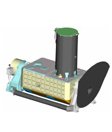
August Editorial

August Editorial
CRISM - NASA's new high tech spectrometer is heading for Mars. |
|
On the 12th of August this year NASA launched its Mars Reconnaissance Orbiter spacecraft. The important mission of the craft is to study the mineral composition of Mars' surface and ultimately whether water is present. Although there is some evidence that in the past there may have been water on Mars, this evidence comes mainly from the shape of some rock formations which seem to show water erosion. However, hard evidence has been lacking and it is NASA's hope that this latest mission will bring direct proof. This proof may be supplied by the Compact Reconnaissance Imaging Spectrometer for Mars, (CRISM for short).
Spectroscopy is a very powerful tool which has long been used to study the mineral composition of rocks through the electromagnetic spectrum which they reflect or emit. The spectrum can come from rocks but can also come from the surface of a planet. As an object reflects energy it creates a spectrum which can be divided into different wavelengths and analysed by a spectrometer. A reflectance spectrum will look somewhat similar to that on the picture on the right. As the rocks absorb some light the the reflection will drop. These low points (indicated by the red stars) are characteristic of certain minerals or molecules. By comparing spectra from the known substance or rock with unknown spectra, we can discover the composition of the unknown substances. For more information about the principles of spectroscopy click on the link. CRISM was built by the Johns Hopkins University Applied Physics Laboratory (APL) in Laurel, Md for two important missions. The main mission will be to examine the mineral composition of rocks at specified locations on Mars. From studies on Earth we know that water leaves certain mineral deposits after prolonged contact with rock. By studying the mineral composition of selected rock formations it should be possible to find out if indeed there was water on Mars in the past. This should certainly bring us closer to the fundamental question of whether ther is life on the Red Planet. The second mission of CRISM is to study atmospheric changes. It will watch for seasonal variations in the dust particles and ice aerosol which should aid understanding of the Martian climate. The Reconnaissance Orbiter is due to reach Mars in March 2006, but it will be another six months before it settles down in orbit and starts sending valuable data. Meanwhile if you would like to build your own miniature copy of the CRISM here is where you find all the information needed.
|
| _______________________________ | ||||
| Home | | | Shopping | | | Database |
© Biscuit Software 2004-2015
All rights reserved